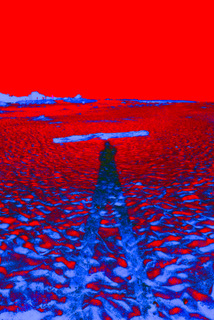As I have aged my interests have converged on the nature of that most mysterious emergent property of matter: con-sciousness. Consciousness arises in biologic matter when atoms are arranged so as to form sensor cells, which respond to chang-es in their external environment; and nerve cells (neurons), which carry the sensory information about the external environment to the brain. The brain itself is a collection of neurons: a neural network that is capable of processing the sensory inputs and producing outputs. The most interesting output is our mind. Consciousness is the running story that our mind tells each of us about our external environment mediated by sensor cells, our internal states such as feelings, and our memories. My art, in this display, involves making false-color prints of digital photographs. Manipulation of each print’s color properties (hue, saturation, luminosity, and contrast) produces the illusion of color planes located at different depths below the surface plane of each print. The illusion is strong for some combinations of colors but absent for others. We live in a 3D world. When we open our eyes and look out at the world we naturally assume that what we see is really out there, in 3D and in full color. But what we see is not “out there.” What we see is in our heads, in our minds. What we see is our experience of what our eyes detect. What we see is what our brains construct from 2D projections made by the lens of our eyes on our eyes’ retinae. Our brains reconstruct the whole image, everything “out there”: lines, surfaces, textures, objects, colors, lightness, darkness… Everything! This visual perception is the visual part of the mind’s consciousness. It is not the reality that we probe by the process called science. It is but a shadow of scientific realit, which in turn is but another shadow cast by the Universe. University Professor of Philosophy and Neural Science at New York University, David Chalmers, specializes in the “hard problem” of consciousness. He asserts in his lectures that experience is information from the inside; science is information from the outside. These color prints are “absolutely” flat.They are 2D images. They have the dimensions of height and width, but they are lacking the dimension of depth. This scientific fact is easily verified by measurement with, s, a machinist’s depth gage. This is information from the outside. However, when you look at the prints (if you are like the vast majority of people who look at them) you see planes of color at different depths. This is information from the inside. Understanding color science is hard. Understanding visual perception is harder. The brain’s algorithm(s) for building a 3D picture of the world “out there” from the 2D retinal images detected by our eyes, fail(s) to construct a correct picture of the two dimensionality of these prints. We cannot know reality by only looking at the universe with our eyes because the 2D image at the eyes’ retinae maps onto countless possible 3D interpretations as our visual cortex processes the incoming sensorial input and is forced to resolve ambiguity. Don’t believe me? Close one eye and look at each print again. The color-depth perception will disappear.
Larry McCandlish “Artist’s Shadow Wearing a Driftwood Hat” inkjet print on paper
Cast A Shadow
